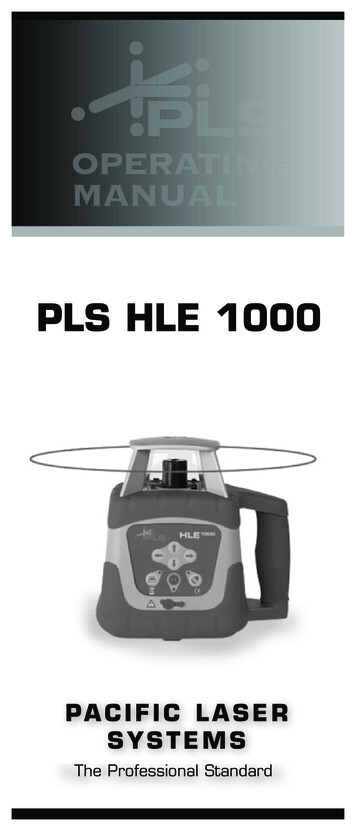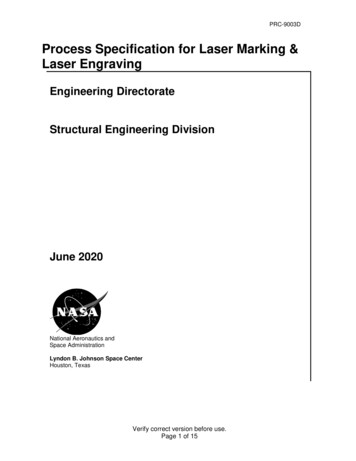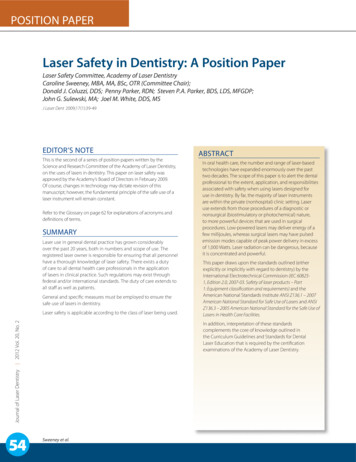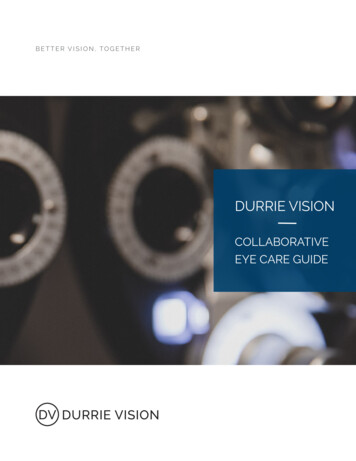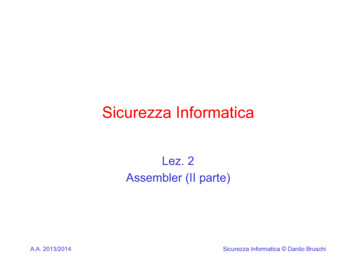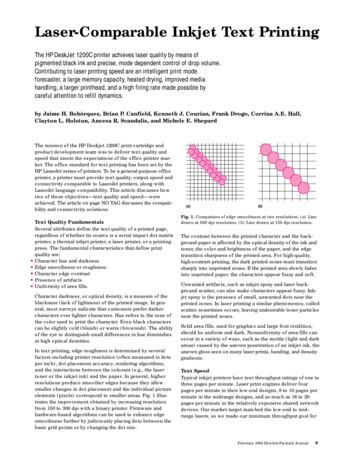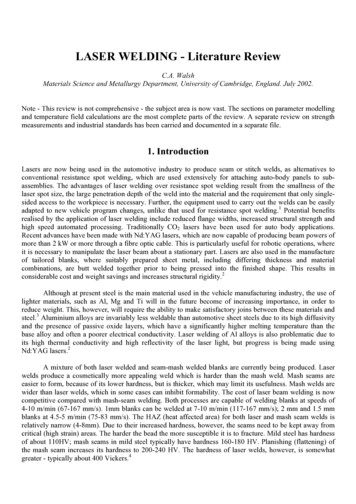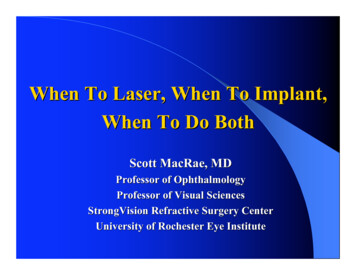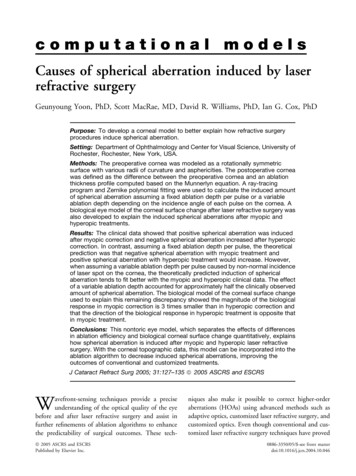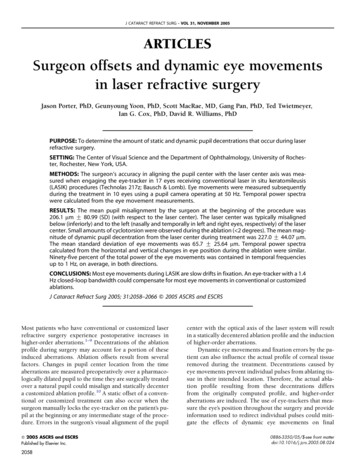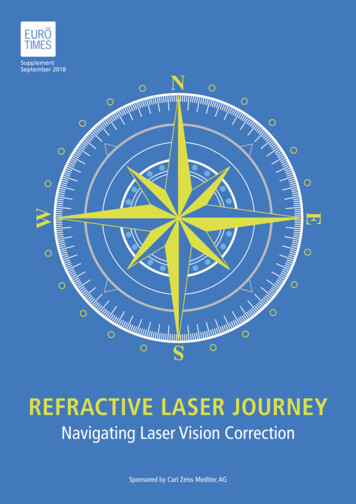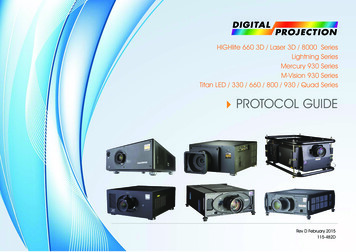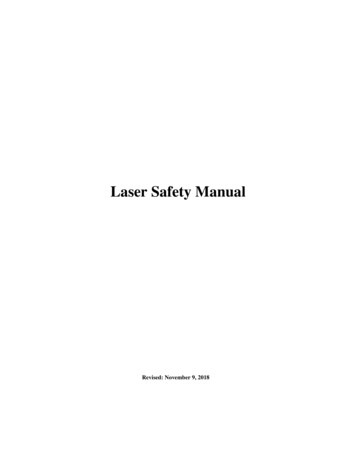
Transcription
Laser Safety ManualRevised: November 9, 2018
Table of ContentsPreface . 1I.Introduction . 2II.Classifications . 2III. Laser Registration . 4IV. Laser Hazards . 4V.Hazard Controls . 7VI. Responsibilities . 12Appendix A (Glossary) .15Appendix B (Control Measures) . 19Appendix C (Registration Form) . 21Appendix D (Reassign/Relocation Form) . 23Appendix E (Incident Report) . 24Appendix F (Example Signs) . 25
PREFACE:This document presents guidelines to help protect Kansas State Universityemployees from the hazards associated with lasers and laser system operations.The intent of this manual is to ensure the safe use of lasers through engineeringand administrative controls. This objective shall be accomplished byidentifying potential hazards, providing recommendations for hazard control,and training laser operators and incidental personnel. The requirements andrecommendations detailed in this program are applicable to all lasers used inresearch and instructional laboratories which are operated by Kansas StateUniversity. All class 3B and 4 laser users must register with the Office ofEnvironmental Health and Safety.This document provides guidance for compliance with applicable State andFederal regulations along with the American National Standard for the SafeUse of Lasers, ANSI Z136.1-2014 and American National Standard forthe Safe Use of Lasers in Research, Development, or Testing, ANSIZ136.8-2012. These are recognized as a minimum standard for laser safety.For any questions or incident reports please call:Laser Safety OfficerPh. (785)532-5856 Email: safety@ksu.edu*In cases of emergencies after hours call campus police (785)532-6412*-1-
Kansas State UniversityDepartment of Environmental Health and SafetyLASER SAFETY PROGRAMI.INTRODUCTIONLASER is an acronym for Light Amplification by Stimulated Emission ofRadiation. Laser is another form of radiation. The light energy generated by alaser is in or near the optical spectrum of light and amplified to extremely highintensity. This light energy is expressed as a laser's wavelength in nanometers(nm). The laser is an intense, highly directional beam of light that can bedirected, reflected, or focused on an object. The object will partially absorb thelight, raising the temperature of the surface and/or interior of the object, andcausing changes in the object. The primary mechanism of beam damage formost lasers therefore, is thermal. When the wavelength of the laser is in theultraviolet (UV) region, then photochemical effects can occur in the object. Theintensity of the radiation that may be emitted and the associated potentialhazards depend upon the type and classification of laser, the wavelength of theenergized beam, and the proposed uses of the laser system.The safe use of laser systems depends upon the basic principles of recognition,evaluation, and control of potential hazards. This program will review laseroperations, the associated potential hazards, responsibilities of the laser usercommunity, and the services provided by the Department of EnvironmentalHealth and Safety to help in the safe use of laser radiation.II.CLASSIFICATIONSLasers are divided into a number of classes depending upon the power or energyof the beam and the wavelength of the emitted radiation. Laser classification isbased on the laser’s potential for causing immediate injury to the eye or skinand/or potential for causing fires from direct exposure or reflection off diffuseand reflective surfaces. Commercially produced lasers have been classified andidentified by labels affixed to the laser since August 1, 1976. In cases where thelaser has been fabricated on campus or is otherwise not labeled, the LSO willassist with labeling the laser including power, wavelength, and exposureduration.A. Class 1 laser or laser system- cannot emit levels of optical radiationabove the exposure limits for the eye under any exposure conditionsinherent in the design of the laser product. For visible laser withwavelengths longer than 500 nm, the limit is 0.4 mW. For lasers ofwavelengths shorter than 500 nm, the limit is 0.04 mW. There may be amore hazardous laser embedded in the enclosure of a Class 1 product, but-2-
no harmful radiation can escape from the enclosure. Class 1 lasers or lasersystems are relatively safe, as long as the system is not modified.B. Class 1M laser system- a class 1 laser using magnifying optics.Incapable of causing injury during normal operation unless collectingoptics are used.C. Class 2 laser or laser system- emits a visible laser beam which by itsvery bright nature will be too dazzling to stare into for extended periods.Momentary viewing is not considered hazardous. The upper radiantpower limit on this type of device is 1 mW which corresponds to the totalbeam power entering the eye for a momentary exposure of 0.25 seconds.Class 2 lasers or laser system requires no special safety measures otherthan not staring into the beam.D. Class 2M laser system- a class 2 laser using magnifying optics. Visiblelasers incapable of causing injury in 0.25 seconds unless collecting opticsare used.E. Class 3 laser- can emit any wavelength, but cannot produce a diffuse orscattered reflection hazard unless focused or viewed for extended periodsat close range. Safety training must be completed by the laboratorypersonnel before using these lasers. In addition, the laser should beoperated within a well marked and controlled area. Class 3 is divided intotwo sub-classes 3R (formally 3A) and 3B.1. Class 3R lasers are “Marginally Unsafe.” This means that the aversionresponse is not adequate protection for a direct exposure of the eye tothe laser beam, but the actual hazard level is low, and minimumprecautions will result in safe use. This sub-class only allows visiblelasers with a maximum continuous wave (CW) power of 5mW and aninvisible laser with a CW power of up to 5 times the Class 1 limit. It isalso not considered a fire or serious skin hazard. Since the outputbeam of such a laser is definitely hazardous for intrabeam viewing,control measures must eliminate this possibility.2. Class 3B lasers are hazardous for direct eye exposure to the laser beam,but diffuse reflections are not usually hazardous (unless the laser isnear the class limit and the diffuse reflection is viewed from a closedistance). This sub-class includes continuous wave (CW) or repetitivepulse lasers with a maximum average power of 0.5 W. The maximumpulse energy for a single pulse class 3B laser in the visible and near IRvaries with the wavelength. For visible lasers the maximum pulseenergy is 30mJ. It increases to 150 mJ per pulse in the wavelengthrange of 1050-1400 nm. For UV and the far Infrared (IR) the limit is125 mJ. Class 3B lasers operating near the upper power or energylimit of the class may produce minor skin hazards. Most Class 3Blasers do not produce diffuse reflection hazards. However, single-3-
pulse visible or near IR class 3B lasers with ultra-short pulses canproduce diffuse reflection hazards at more than a meter from thesurface. Eye protection may be needed while the laser is operating.The Laser Safety Officer (LSO) must perform a hazard analysis on thelab before operation of the laser.F. Class 4 laser- any that exceeds the Annual Exposure Limit (AEL) of aClass 3 device. Class 4 lasers have an average power level greater than0.5 W. The lower power limit for single pulse Class 4 lasers varies from0.03 J for visible wavelengths to 0.15 J for some near IR wavelengths.These lasers are powerful enough to be a fire, skin, and diffuse reflectioneye hazard. Class 4 lasers require the use of eye protection, facilityinterlocks, and special safeguards. The LSO must perform a hazardanalysis on the lab before operation of the laser.III.LASER REGISTRATIONThe Principle Investigator is responsible for all safety precautions described inthis manual that pertain to his/her laser systems. A Laser Registration Form(Appendix C) must be completed and returned to the LSO for each Class 3B,and 4 laser systems used within research and instructional laboratories. Anychanges in the use of the laser, laser location, and/or transfer of a laser requireLSO notification. The Laser Relocation Form (Appendix D) must be filled outand faxed (532-1981) to the LSO prior to moving a laser or laser system. Ifyou have any questions about completing the laser registration form orrelocation form, please contact the LSO at 532-5856 or by email atsafety@ksu.edu.IV.LASER HAZARDSA. Beam Hazards- Destruction of tissue can occur to the eye and skin. Inthe far-UV and far-IR regions of the optical spectrum, the cornea willabsorb the laser energy and be damaged. In the near-UV region and nearIR at certain wavelengths the lens may be damaged. The greatest hazardsare 400 - 1400 nm wavelengths which can damage the retina. Lasersbelow the visible spectrum ( 1400 nm) are especially dangerous becausethe eye does not have a natural aversion at these wavelengths. Keep inmind that the light entering the eye from a collimated beam in the retinalhazard region is concentrated by a factor of 100,000 times when it strikesthe retina. If the eye is not focused at a distance or if the laser light hasbeen reflected off diffuse surfaces, this hazard is greatly diminished butcan still be very dangerous.There are a variety of types of beam exposures that are not limited tointrabeam viewing. For high powered laser, the specular or diffusereflection may be equally as damaging.-4-
Direct Intrabeam exposure.Diffuse Reflection.Specular Reflections.Intrabeam exposure: The skin or eye is exposed directly to all orpart of the laser beam resulting in a fullexposure to the irradiance of the beam.Specular reflection:The reflection from a smooth or mirroredsurface. Items such as jewelry or cover glassof wrist watches produce specular reflections.These items should be removed prior tooperating a laser. Exposure to specularreflections can be as dangerous as anintrabeam viewing.Diffuse reflections:Reflection off a non-uniform or rough surface.Diffuse reflection scatter the beam and doesnot carry the full power of an intrabeamexposure like in specular reflections.However, diffuse reflections from Class IVlasers can contain enough power to initiate afire.B. Electrical Hazards- The most common hazard encountered in laser use iselectric shock. Potentially lethal electrical hazards may be present-5-
especially in high-powered laser systems. To reduce electrical hazards,high voltage sources and terminals must be enclosed unless the work areais restricted to qualified persons only. Whenever feasible, power must beturned off and all high-voltage points grounded before working on powersupplies. Capacitors must be equipped with bleeder resistors, dischargedevices, or automatic shorting devices.Other general guidelines to follow include: Never wear jewelry when operating a laser. Metal jewelry canbe conductive. Jewelry in general can create a specularreflection hazard. This includes wrist watches. Use the one hand rule when working on circuits (make sure notto ground yourself). Avoid standing in water and assume that all floors areconductive when working with high voltage. Use rubber gloves and insulating floor mats when available. Do not work alone. Maintain access to main power shutoff.C. Chemical Hazards- Some material used in laser systems (excimer, dye,chemical lasers) may be hazardous or toxic substances. Also, laserinduced reactions may produce hazardous particles or gases around thelaser system.D. Fire Hazards- Solvents used in dye lasers may be extremely flammable.Ignition may occur via high voltage pulses or flash lamps. Direct beamsand unforeseen specular reflections of high-powered CW infrared lasersare capable of igniting flammable materials during laser operation. Otherpotential fire hazards are electrical components and the flammability ofClass IV laser beam enclosures.E. Compressed Gases- Many hazardous gases are used in lasers includingchlorine, fluorine, hydrogen chloride and hydrogen fluoride. Standardoperating procedure must be developed for the safe handling ofcompressed gases which include: Cylinders can not be free standing. They must be attached to acart or secured by a chain or strap. Gases of different categories (toxics, corrosives, flammables,oxidizers) must be stored separately.-6-
F. UV Radiation- Laser discharge tubes and pumping tubes may emithazardous levels of ultraviolet radiation called “collateral UV” and shouldbe suitably shielded. UV radiation can cause photodermatitis as a result ofexposure to some industrial chemicals or medications.G. Laser Dyes and Solutions- Laser dyes are complex fluorescent organiccompounds which, when in solution with certain solvents, form a lasingmedium for dye lasers. Certain dyes are highly toxic or carcinogenic.These dyes are frequently changed and special care must be taken whenhandling, preparing solutions, and operating dye lasers. A Material SafetyData Sheet (MSDS) for dye compounds shall be made available to allappropriate workers.H. Laser Generated Air Contaminants (LGAC) - Air contaminants maybe generated when certain Class IIIB and Class IV laser beams interactwith matter. The quantity, composition, and chemical complexity of theLGAC depend greatly upon the target material, cover gas, and beamirradiance. The LSO will ensure that the industrial hygiene aspects ofexposure to LGAC are addressed and that the appropriate controlmeasures are used.V.HAZARD CONTROLSA. The hazard controls necessary for the safe use of laser radiation dependsupon:1. The laser classification2. The environment where the laser is used3. The laser operating characteristics4. The persons operating the laser5. The general population within the vicinity of the laserLaser safety procedures can best be evaluated by grouping them accordingto the class of laser in use. Appendix B of this program provides a list ofappropriate control measures for each laser classification.B. Review of repeated incidents have demonstrated that accidental eye and/orskin exposures to laser radiation, and accidents related to the ancillaryhazards of a laser or laser system, are most often associated with personnelinvolved with the use of these systems under the following conditions:1. Unanticipated eye exposure during alignment-7-
2. Misaligned optics3. Available eye protection not used4. Equipment malfunction5. Improper method of handling high voltage6. Intentional exposure of unprotected personnel7. Operator unfamiliar with laser equipment8. Lack of protection for ancillary hazards9. Improper restoration of equipment following service10. Inadvertent beam discharge11. Insertion of flammable materials into beam pathC. Engineering Controls- Engineering controls are the priority means ofminimizing the possibility of accidental exposures to laser hazards. Ifengineering controls are impractical or inadequate, then safety should besupported through the use of administrative procedures and personnelprotective equipment. Engineering controls that may prove useful andeffective in improving the safety of a laser or laser system are provided inthe following list:1. Protective Housing and Interlocks- A protective housing is aphysical barrier sufficient to contain the beam and laser radiation fromexiting the laser system so that the maximum permissible exposure(MPE) is not exceeded on the outside surface. Protective housingsmust be interlocked so that the laser cannot operate when the housingis opened or removed. When the requirement of a protective housingare fulfilled, the laser system is considered a Class I laser and nofurther control measures are required. If the interlock is overridden orremoved, usually for maintenance by a qualified individual, then thelaser is no longer a Class I system and proper control measures mustbe used.2. Laser Use Without Protective Housing- In the research environment,lasers are often used without protective housing in place. The use ofoptical tables and optical devices are typically employed in order tomanipulate the laser beam. In this environment, the LSO will evaluatethe hazards and recommend control measures to ensure safe operation.These control measures may include but are not limited to thefollowing:-8-
Access restriction (see below) Area controls (see below) Barriers, curtains, and beam stops (see below) Procedural controls Eye protection Training3. Access Restriction- For Class 3B and 4 laser laboratories, accesscontrols are required to prevent unauthorized personnel from enteringthe area when the laser is in use. Doors must be kept closed when thelaser is in operation. Secondary doors that can allow access to a laserin operation must be either locked or interlocked and must havesignage similar to the primary entrance. Special cases will bereviewed by the LSO.4. Area Control- Class 3B and 4 laser area control measures are used tominimize laser radiation hazards. The area must be posted with theappropriate signage and include a lighted sign or indicator light at thedoorway indicating the “ON” status of a laser system. Only authorizedpersonnel who have been appropriately trained will be allowed tooperate the laser. Control of the laser beam path shall be accomplishedin the following manner: Totally Enclosed Beam Path- where the entire beampath is unenclosed, a laser hazard analysis shall beperformed by the LSO to establish the nominal hazardzone (NHZ) if not furnished by the manufacturer oravailable as part of the classification. Limited Open Beam Path- Where the beam path isconfined to significantly limit the degree of accessibilityof the open beam, a hazard analysis shall be performedby the LSO to establish the NHZ. Enclosed Beam Path- When the protective housingrequirements are temporarily relaxed such as duringservice, the LSO shall establish the appropriatecontrols. These may include a temporary area controland administrative and procedural controls.-9-
5. Barriers, Enclosures, and Beam Stops- Beam barriers, enclosures,and stops are used to prevent beam propagation outside of thecontrolled access area in excess of the MPE. It is always desirable toenclose as much of the beam path as possible. As with a protectivehousing, the proper enclosure of the entire beam path may change thelaser system to a Class 1 laser. When the beam needs to be directed toanother area such as between optical tables, enclosure of the beam isrecommended. Physical barriers are used to prevent laser radiationfrom exiting the systems. Rail curtains can be used to completelyenclose an optical table or part of the laser system. Due to the powerdensity of Class 3B and 4 lasers, the combustible properties of thebarrier material must be evaluated and certified. Beam stops are usedto prevent the beam from leaving the optical table and to terminate thebeam path. Beam stops are to be used behind optical devices in theevent that the beam becomes misaligned.D. Administrative Controls- If administrative controls are impractical orinadequate, then safety should be supported through the use ofadministrative procedures and personnel protective equipment.1. Standard Operating Procedures (SOP’s) - A written SOP must beestablished for normal use, maintenance, and alignment operations.The SOP’s will be maintained with the laser equipment for referenceby operators or service perso
laser is in or near the optical spectrum of light and amplified to extremely high intensity. This light energy is expressed as a laser's wavelength in nanometers (nm). The laser is an intense, highly directional beam of light that can be directed, reflected, or focused on an object. The object will partially absorb theFile Size: 558KB
